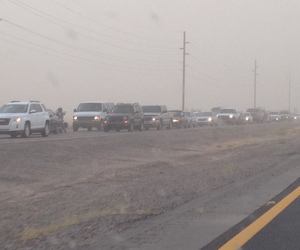
Every year dust storms wreak havoc for Arizona drivers during the summer months causing an average of five deaths per year, according to Arizona Department of Transportation.
“There’s no such thing as a forecast for dust storms,” said Mike Bruce, a meteorologist with the Phoenix office of the National Weather Service.
Although some climatologists make long-range forecasts for dust storms, Bruce said, it’s very hard to do and there is not any reliable science behind it.
There are, however, short-term signs a dust storm could be on its way.
“Thunderstorms will produce dust,” Bruce said.
“The conditions are quite dry out there, similar to last year,” he said. “When they’re that dry it tends to enhance the dust storms that do occur.”
Bruce has been a resident of Maricopa since 2004 and often commutes along State Route 347. Although the entire 16-mile stretch from Maricopa to Interstate 10 is susceptible to dust storms, he said the most dangerous area is from the Gila River bottom to Riggs Road.
“In that particular area, there’s very little vegetation,” Bruce said. “That area has kind of given way to sandy soil.”
The conditions along that region do not even need a storm to pass through to cause severe dust conditions. Even relatively high winds can produce significant amounts of dust.
ADOT spokesman Dustin Krugel said it is important to avoid dust storms if at all possible.
“I can’t emphasize enough, though, how important it is for drivers to avoid driving into a dust storm and why pulling aside, off the roadway could save a life.”
If a driver sees an area in front of them with very limited visibility, ADOT advises drivers to stop.
“That’s the time you should try to find a way to get off the roadway and let it pass,” Krugel said.
“A lot of these dust storms that we get in Southern Arizona happen very quickly and seem to pass quickly,” he said. “It’s just better to wait it out.”
This summer, ADOT has a statewide, multidimensional campaign spreading awareness about the dangers of dust storms and what people can do to protect themselves while driving in one.
The slogan “pull aside to stay alive” is used by the department to educate drivers about pulling off the road safely and as soon as possible when encountering a dust storm.
If drivers do get caught in a dust storm, they need to check their surroundings by looking toward the front, back and side of their vehicle for any potential hazards. Once it appears to be safe, drivers should slow down and pull off the roadway.
“You don’t want to stop in the travel lane or the emergency lane,” Krugel said. “You want to look for a place to pull completely off the paved portion of the roadway.”
Krugel said when a driver brings a vehicle to a stop, it is important to remember:
• Turn off lights (including emergency flashers)
• Pull emergency brake, take foot off brake
• Keep seatbelt fastened
***ADVERTISEMENT***If a vehicle’s lights are left on while parked off to the side of the roadway, it could cause an accident, Krugel said. Other drivers will be experiencing limited visibility as well and may follow the light thinking the lane of traffic is where the parked vehicle sits.
Drivers with high-profile vehicles like SUVs should remain even more cautious when driving in dust storms because the high winds producing dust in the air could cause taller vehicles to lose control or flip over.
“You’ll see that all around the country,” Krugel said.
Since dust storms can strike without warning and create hazardous driving conditions, Krugel emphasized the importance of drivers understanding they play a key role in their own safety.
“When they encounter a dust storm, it’s critical that they know what to do,” Krugel said.


![Maricopa’s ‘TikTok Rizz Party,’ explained One of several flyers for a "TikTok rizz party" is taped to a door in the Maricopa Business Center along Honeycutt Road on April 23, 2024. [Monica D. Spencer]](https://www.inmaricopa.com/wp-content/uploads/2024/04/spencer-042324-tiktok-rizz-party-flyer-web-218x150.jpg)



![Locals find zen with Earth Day drum circle Lizz Fiedorczyk instructs a drum circle at Maricopa Community Center April 22, 2024. [Brian Petersheim Jr.]](https://www.inmaricopa.com/wp-content/uploads/2024/04/PJ_3922-Enhanced-NR-218x150.jpg)


![Shred-A-Thon to take place tomorrow An image of shredded paper. [Pixabay]](https://www.inmaricopa.com/wp-content/uploads/2024/03/shredded-paper-168650_1280-218x150.jpg)


![Alleged car thief released without charges Phoenix police stop a stolen vehicle on April 20, 2024. [Facebook]](https://www.inmaricopa.com/wp-content/uploads/2024/04/IMG_5040-218x150.jpg)



